
“Several mitigation initiatives, including promotion of affordable renewable technologies, measures towards energy efficiency, implementation of mass transport systems and expansion of hydroelectricity potential, are already part of our development strategy,” PM Nawaz had told the world at the time.
What he conveniently decided not to mention was his country’s interest in tapping into its vast coal reserves to address the national energy crisis; to use a fossil fuel which is labelled the world's single greatest climate threat.
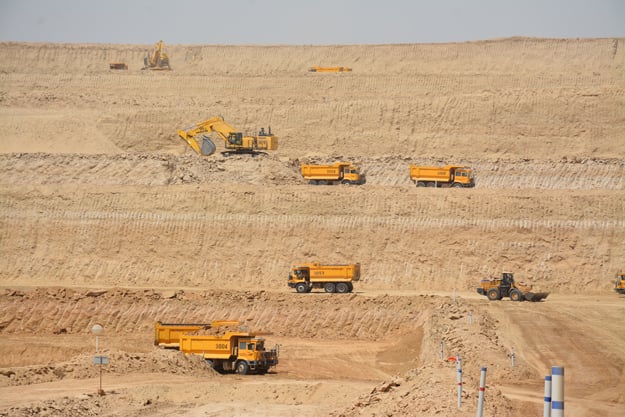 Dumpers working at a mining site in the Thar Desert. PHOTO: SECMC
Dumpers working at a mining site in the Thar Desert. PHOTO: SECMCWhy is coal bad?
Coal is a rock formed when dead plants and animals decompose and solidify underground over the years. The fossil fuel acquired significance in the global arena during the Industrial Revolution when it was used to power steam engines and produce electricity. By 2013, it was providing over 40 per cent of the world’s electricity needs.
However, burning coal releases carbon dioxide – a vital yet heat-trapping gas – into the atmosphere and makes the planet warmer than 'normal'. In 2016, the atmospheric concentration of carbon dioxide crossed the dangerous 400 parts-per-million threshold and scientists warned that increased use of coal is driving the planet towards a serious climate catastrophe, which will be irreversible.
In this backdrop, there is an overwhelming consensus in the scientific and political communities of the world that coal must remain in the ground and countries should instead focus on investing in renewable energy sources such as solar and wind. However, Pakistan’s plans to mine and burn coal on a massive level are ringing alarm bells far and wide.
Thar coal project
The coal reserves in Pakistan’s Thar Desert spread over more than 9,000 sq/km of land and are estimated to be 175 billion tonnes in quantity. Believed to be one of the largest coal deposits in the world, Thar's reserves are believed to be equivalent to the total oil reserves of Saudi Arabia and Iran (in terms of heating value) and can produce 100,000MW of electricity for three centuries.
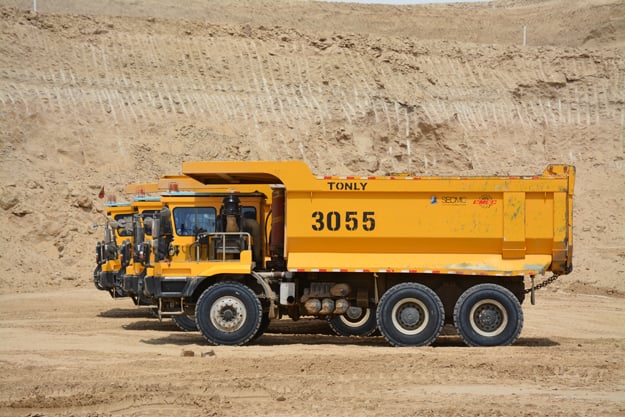 The mining site has to be dug up in order to reach the deposits of coal. PHOTO: SECMC
The mining site has to be dug up in order to reach the deposits of coal. PHOTO: SECMCTo tap into this vast unexploited resource, the government has allowed Sindh Engro Coal Mining Company (SECMC) to utilise one per cent of the total coal reserves as part of the many power projects taking place under the China-Pakistan Economic Corridor scheme. With the 1.57 billion tonnes of coal that lie underground, the company aims to produce 660MW electricity by June 2019, 1,320MW by December 2019 and 3,300MW by 2022.
Work on the Thar coal project has begun, but SECMC is facing criticism as there are concerns regarding land rights of the people of Thar, groundwater depletion, and environmental deterioration.
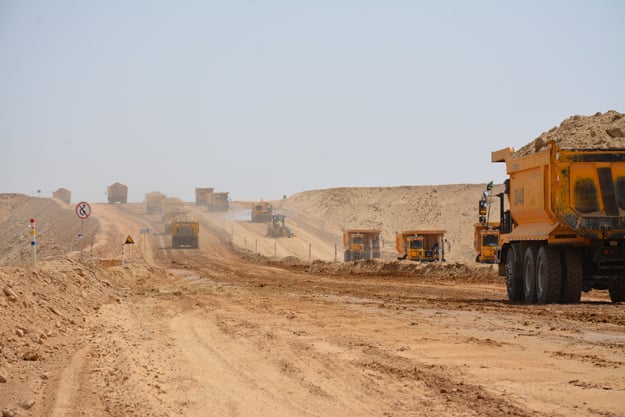 Dumpers transporting the excavated material from the mining site. PHOTO: SECMC
Dumpers transporting the excavated material from the mining site. PHOTO: SECMCIn order to begin coal extraction, SECMC has started to dry the mine by extracting water from the area. The extracted water has no toxic or heavy metals, but it is still not safe for drinking. The water will be transferred and stored in a large reservoir which spreads across 1,500 acres. Locals from Gorrano village, which is located right next to the reservoir, have their reservations as they have lost space for livestock grazing due to the construction of the reservoir and fear seepage from it will pollute groundwater which they are dependent on.
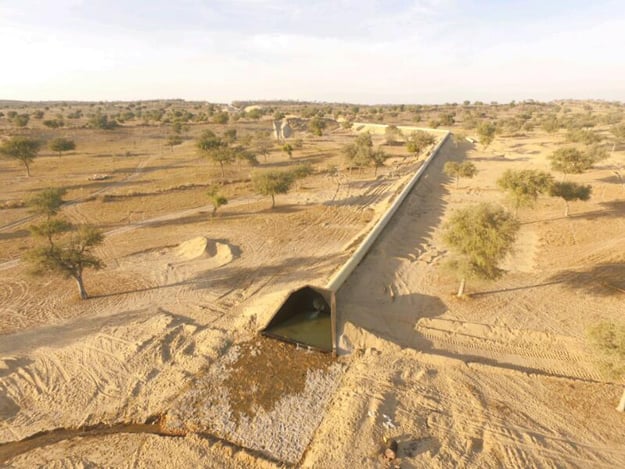 The pipeline which brings extracted water from the mine site to the reservoir. PHOTO: SECMC
The pipeline which brings extracted water from the mine site to the reservoir. PHOTO: SECMCPehlaj, a 40-year-old father of seven from Gorrano, is among the many Tharis who have been staging a sit-in outside the Islamkot Press Club for several months. Speaking to The Express Tribune, Pehlaj said Gorrano is among 12 villages which will likely be affected by the reservoir. “The government has not yet compensated everyone on whose land the reservoir is built. We will not end the protest unless the reservoir is moved,” he said, adding that approximately 18,000 would be affected at its current location.
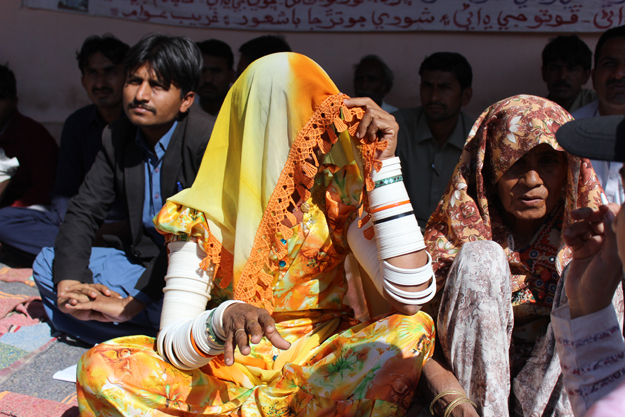 Men and women come together to protest outside Islamkot Press Club, urging the government to stop construction of the reservoir. PHOTO: ZOFEEN T EBRAHIM
Men and women come together to protest outside Islamkot Press Club, urging the government to stop construction of the reservoir. PHOTO: ZOFEEN T EBRAHIMSECMC, however, dismisses the claim and said there are only three villages settled outside the reservoir area with a total population of approximately 3,000, and that none of them will be relocated. The matter of land acquisition and compensation is being dealt under the Land Acquisition Act 1894 and by the Sindh Revenue Department, a spokesperson explained.
Other Engro officials said 968 out of 1,500 acres belong to the government and only 532 acres are privately owned. The government, they said, has so far paid Rs300,000 per acre to the legal owners of 268 acres.
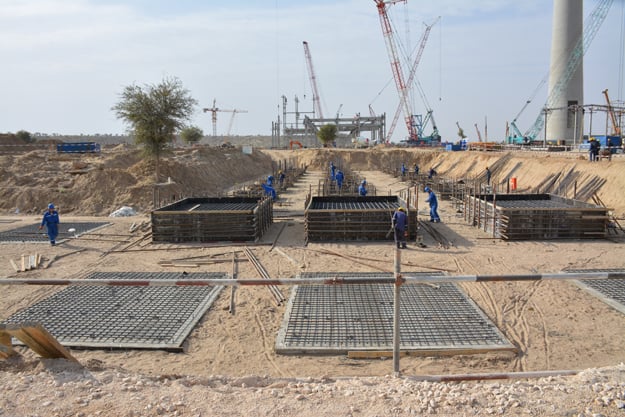 Construction work underway at the mining site. PHOTO: SECMC
Construction work underway at the mining site. PHOTO: SECMCThere is, however, a plan to relocate 171 families from Senhri Dars village, situated at the mining site. In addition to compensating them for their land, the families will also be provided with model houses worth Rs3 million each. The new settlement where the village will be shifted is four kilometres away from their current residential area.
SECMC, in order to reduce the impact of air pollution for the residents, has decided to build 180-metre tall chimneys, which the company claims will be the tallest civil structure in Pakistan. Regarding the concerns that China may be transferring outdated coal technology as part of these power plant project, SECMC CEO Shamsuddin Sheikh said state-of-the-art machinery is being imported, including European boilers.
 One of the chimneys which will release hot gas into the atmosphere. PHOTO: SECMC
One of the chimneys which will release hot gas into the atmosphere. PHOTO: SECMCAnswer to Pakistan’s energy crisis
It is strange that China itself is shunning coal as a source of energy but is encouraging Pakistan to use it to address the energy crisis.
The Asian giant is the world’s top carbon polluter but has reduced its reliance on coal in the last decade and has been shifting towards renewable energy. It has shut down its last large coal power plant in Beijing and has also announced a plan to cancel 100 more in other parts of the country. The national government has also invested US$361 billion in the renewable power generation sector which will not just shift the country to clean energy but will create 13 million jobs as well. As a result of these measures, in 2015, China’s carbon emissions declined for the first time in the last 15 years.
 Aerial view of the mining site. PHOTO: SECMC
Aerial view of the mining site. PHOTO: SECMCWhile Thar coal reserves may appear tempting to Pakistan in the face of a relentless power crisis, they are not the only way the country can address the issue.
Dr Adil Najam, a renowned educationist and lead author of IPCC’s third and fifth assessment reports, rightly says the great transition in energy is already happening. “Coal is out. Solar and wind are in. Renewables can now be produced at megawatt-scale and they are now at or near cost-competitive levels,” he says.
“The idea that Pakistan has no alternatives to coal as an energy source is simply wrong. But also wrong is the idea that there has to be a single alternative to coal. The energy economy of the future will be a multi-sourced economy. What that means is that coal is not going to be ‘replaced’ by wind, solar, geothermal, ocean wave or any other singular ‘magic’ technology. It is going to be replaced by a combination of all these technologies and by many others,” he further explained.
According to Najam, none of the many alternative energy sources that are available can ‘alone’ replace coal. “But together, they have the potential to meet Pakistan’s needs. However, this will require thinking not in terms of energy ‘projects’ but in terms of energy ‘policy’ and even energy ‘strategy’,” Najam stressed.
Syed Muhammad Abubakar is an international award-winning environmental writer with an interest in climate change, deforestation, food security and sustainable development. He tweets @SyedMAbubakar and can be reached at s.m.abubakar@hotmail.com
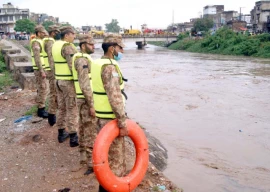

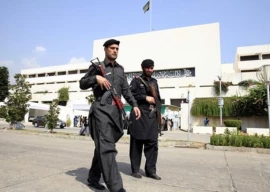















COMMENTS
Comments are moderated and generally will be posted if they are on-topic and not abusive.
For more information, please see our Comments FAQ